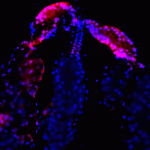Link to Pubmed [PMID] – 27171170
PLoS Pathog. 2016 May;12(5):e1005548
Vertical transmission (VT) and horizontal transmission (HT) of pathogens refer to parental and non-parental chains of host-to-host transmission. Combining HT with VT enlarges considerably the range of ecological conditions in which a pathogen can persist, but the factors governing the relative frequency of each transmission mode are poorly understood for pathogens with mixed-mode transmission. Elucidating these factors is particularly important for understanding the epidemiology of arthropod-borne viruses (arboviruses) of public health significance. Arboviruses are primarily maintained by HT between arthropod vectors and vertebrate hosts in nature, but are occasionally transmitted vertically in the vector population from an infected female to her offspring, which is a proposed maintenance mechanism during adverse conditions for HT. Here, we review over a century of published primary literature on natural and experimental VT, which we previously assembled into large databases, to identify biological factors associated with the efficiency of arbovirus VT in mosquito vectors. Using a robust statistical framework, we highlight a suite of environmental, taxonomic, and physiological predictors of arbovirus VT. These novel insights contribute to refine our understanding of strategies employed by arboviruses to persist in the environment and cause substantial public health concern. They also provide hypotheses on the biological processes underlying the relative VT frequency for pathogens with mixed-mode transmission that can be tested empirically.

